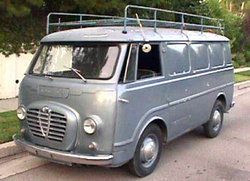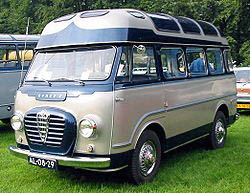Difference between revisions of "Romeo Autotutto"
m |
m |
||
| (13 intermediate revisions by the same user not shown) | |||
| Line 3: | Line 3: | ||
{| border=1 cellspacing=3 cellpadding=4 style="float:right; margin:0 0 .5em 1em; width:250px; background:#505050; border-collapse:collapse; border:1px solid #999; font-size:83%; line-height:1.5; " summary="Infobox Automobile" | {| border=1 cellspacing=3 cellpadding=4 style="float:right; margin:0 0 .5em 1em; width:250px; background:#505050; border-collapse:collapse; border:1px solid #999; font-size:83%; line-height:1.5; " summary="Infobox Automobile" | ||
|- style="text-align:center; background:#505050;" | |- style="text-align:center; background:#505050;" | ||
| − | | colspan=2 style="padding:0; background:#333333; color:#fff; border-bottom:1px solid #999;" | | + | | colspan=2 style="padding:0; background:#333333; color:#fff; border-bottom:1px solid #999;" |[[Image:Alfa Romeo Van.jpg|250px]] |
|- style="color:#fff; background:darkred; font-size:larger;" | |- style="color:#fff; background:darkred; font-size:larger;" | ||
! colspan=2 |'''Romeo Autotutto A12''' | ! colspan=2 |'''Romeo Autotutto A12''' | ||
| Line 32: | Line 32: | ||
|} | |} | ||
| − | + | ||
| − | |||
== 1954 - == | == 1954 - == | ||
| − | + | ||
| + | |||
It may be hard to believe, but then in the 1950s where all the Alfa Romeo-cars were "real" Alfa with rear wheel drive, and where no one had heard of [[Alfasud]] or Alfa with front wheel drive, which was actually produced small vans with the Alfa Romeo logo and front wheel. This was done in 1954 at its plant in [[Pomigliano d'Arco]], 15 km north to [[Naples]], where Alfasud was located from 1971. | It may be hard to believe, but then in the 1950s where all the Alfa Romeo-cars were "real" Alfa with rear wheel drive, and where no one had heard of [[Alfasud]] or Alfa with front wheel drive, which was actually produced small vans with the Alfa Romeo logo and front wheel. This was done in 1954 at its plant in [[Pomigliano d'Arco]], 15 km north to [[Naples]], where Alfasud was located from 1971. | ||
| + | |||
| + | [[Image:250px-Romeo2.jpg|thumb|left|250px|'''1957 Romeo Autotutto 2 Passenger Van with suicide doors (produced 1954-1967)''']] | ||
The small van was the model code "tipo dieci" or T10, but it was quickly model name '''Romeo'''. It was a competitor to the Volkswagen Type 2 (transporter) from 1950 and was available as a closed van, closed van with one or two rear seats for crew, minibus, pick-up, ambulance, etc. | The small van was the model code "tipo dieci" or T10, but it was quickly model name '''Romeo'''. It was a competitor to the Volkswagen Type 2 (transporter) from 1950 and was available as a closed van, closed van with one or two rear seats for crew, minibus, pick-up, ambulance, etc. | ||
| Line 43: | Line 45: | ||
In 1967, the front lot updated and the model was named the A11/A12 or F11/F12. The A11/A12 were open vehicles such as a pick-up and F11/F12 were closed vehicles minibus. The model could now only be available with petrol engine of 1290 cm3. By A11/F11 model with a maximum load 1.050/1.100 kg engine had a maximum power of 47 hp at 5,000 rpm. By the A12/F12 model with a maximum load of 1.150/1.200kg the engine had a maximum power of 52 hp at 5,200 rpm. Top speed was 103 km/h. There were sold far more A12/F12 than A11/F11 that were deleted in 1971. | In 1967, the front lot updated and the model was named the A11/A12 or F11/F12. The A11/A12 were open vehicles such as a pick-up and F11/F12 were closed vehicles minibus. The model could now only be available with petrol engine of 1290 cm3. By A11/F11 model with a maximum load 1.050/1.100 kg engine had a maximum power of 47 hp at 5,000 rpm. By the A12/F12 model with a maximum load of 1.150/1.200kg the engine had a maximum power of 52 hp at 5,200 rpm. Top speed was 103 km/h. There were sold far more A12/F12 than A11/F11 that were deleted in 1971. | ||
| + | |||
| + | [[Image:800px-AlfaRomeo2_LKW_1.jpg|thumb|left|250px|'''Romeo Autotutto F12 Commercial Ladder Truck (produced 1954-1967)''']] | ||
From 1973 a A12/F12 was available with a 4-cylinder diesel line from Perkins in 1760cc, with a maximum output of 50 hp at 3,800 rpm. The same engine was used in private cars Giulia from 1976. | From 1973 a A12/F12 was available with a 4-cylinder diesel line from Perkins in 1760cc, with a maximum output of 50 hp at 3,800 rpm. The same engine was used in private cars Giulia from 1976. | ||
| Line 48: | Line 52: | ||
In 1977 the party was the front again updated. It was now black plastic around the headlights and radiator grill, and private cars Giulia had plastic radiator grill in 1974. | In 1977 the party was the front again updated. It was now black plastic around the headlights and radiator grill, and private cars Giulia had plastic radiator grill in 1974. | ||
| − | |||
| + | |||
| + | |||
| + | |||
| + | |||
| + | |||
| + | |||
| + | |||
| + | |||
| + | |||
| + | |||
| + | |||
| + | |||
| + | |||
Send what you heve to: | Send what you heve to: | ||
*[mailto:[email protected] '''[email protected]'''] | *[mailto:[email protected] '''[email protected]'''] | ||
Latest revision as of 09:10, 3 June 2009
1954 -
It may be hard to believe, but then in the 1950s where all the Alfa Romeo-cars were "real" Alfa with rear wheel drive, and where no one had heard of Alfasud or Alfa with front wheel drive, which was actually produced small vans with the Alfa Romeo logo and front wheel. This was done in 1954 at its plant in Pomigliano d'Arco, 15 km north to Naples, where Alfasud was located from 1971.
The small van was the model code "tipo dieci" or T10, but it was quickly model name Romeo. It was a competitor to the Volkswagen Type 2 (transporter) from 1950 and was available as a closed van, closed van with one or two rear seats for crew, minibus, pick-up, ambulance, etc.
Romeo Autotutto (all purpose) were presented at the Automobile exhibition in Turin in 1954 as a closed van and a minibus with a diesel engine at 1158cc and gasoline in 1290cc. Diesel engine was a 2-cylinder line with a Roots compressor and peak power of 31 hp at 2,800 rpm, which gave a top speed of 75 km/h. Petrol engine was a 4-cylinder line with two chain-driven, overhead camshafts, a compression of only 7,5:1 and peak power of 37hp at 3,500 rpm, which gave a top speed of 94 km/h. Petrol engine was a "reduced" version of the engine which was later used in Giulietta Berlina.
In 1967, the front lot updated and the model was named the A11/A12 or F11/F12. The A11/A12 were open vehicles such as a pick-up and F11/F12 were closed vehicles minibus. The model could now only be available with petrol engine of 1290 cm3. By A11/F11 model with a maximum load 1.050/1.100 kg engine had a maximum power of 47 hp at 5,000 rpm. By the A12/F12 model with a maximum load of 1.150/1.200kg the engine had a maximum power of 52 hp at 5,200 rpm. Top speed was 103 km/h. There were sold far more A12/F12 than A11/F11 that were deleted in 1971.
From 1973 a A12/F12 was available with a 4-cylinder diesel line from Perkins in 1760cc, with a maximum output of 50 hp at 3,800 rpm. The same engine was used in private cars Giulia from 1976.
In 1977 the party was the front again updated. It was now black plastic around the headlights and radiator grill, and private cars Giulia had plastic radiator grill in 1974.
Send what you heve to:
External Links
| Car Information and Photos by Marque: A - B - C - D - E - F - G - H - I - J - K - L - M - N - O - P - Q - R - S - T - U - V - W - X - Y - Z |
| Motorcycle Information and Photos by Marque: A - B - C - D - E - F - G - H - I - J - K - L - M - N - O - P - Q - R - S - T - U - V - W - X - Y - Z |


